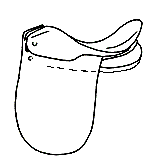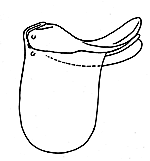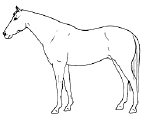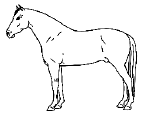Saddle Fitting- Part 2
Here is Part 2 of Saddle Fitting…Saddle fit is SO important and even more important than finding a saddle that WE like, we need to make sure our HORSE likes it. An ill fitting saddle cause countless problems – which we will discuss later on in the month- and the correct fit should never be underestimated.
So I’d like to share this article from www.showhorsepromotions.com.
Written by Connie Micheletti
Bridging
Unfortunately, as you increase the thickness of the panel by adding a gusset, the entire panel becomes more and more flat from front to back. Turn your saddle upside down and look at the panel – does it have a slight “banana” shaped curve or is it relatively straight and flat from front to back?
Now look at your horse – can you take a piece of 2×4 the length of your saddle, sit it on his back and have it follow the contour? If the answer is “yes” (and it is with many Warmbloods) then the gusset panel saddle is for you!
If, however, your horse’s back drops a little after his withers then slopes slightly upward toward his croup, your piece of 2×4 will contact his body only in the front and back. This is “bridging” and it can be as extreme as the 2×4 example or very subtle, resulting only in differentials of pressure.

Gusset Panel
No matter how subtle it is it will be uncomfortable for the horse and will usually result in soreness and tightness in the loin area. Sensitive horses may object violently while more stoic individuals will probably become regular patients for equine chiropractors and massage therapists.

Tradition Panel
Frequently riders become concerned whether the “banana” shape of traditional panels provide an optimum amount of support for the horse. It’s certainly true that gusset panels have a greater surface area than traditional panels and the question of support may indeed be an important factor if the rider is a large, heavyweight person. But since the majority of dressage riders are men and women of normal stature, this rarely causes any problem for the horse and is certainly to be preferred to a heavy weight being pressed into his loins.

Compare your horse’s topline to the illustrations below – Thoroughbred type on the left and Warmblood type on the right. If he is shaped like the horse on the left, a gussetted panel is probably not a good choice.
right. If he is shaped like the horse on the left, a gussetted panel is probably not a good choice.
When your saddle requires reflocking, be sure to chose a qualified craftsman for the job. A poorly reflocked panel will have lumps that will cause uneven pressure and discomfort for your horse.
Saddle Care
Frequent oiling is not necessary to insure good service from your saddle. As a matter of fact, precisely the opposite is true. Americans tend to over oil their tack while in Europe oil is used very infrequently. Regular cleaning with a quality glycerin soap will maintain your saddle in top condition – keeping the leather supple yet sturdy. If the leather in your saddle begins to feel dry or stiff from use or neglect, use a quality leather oil product sparingly.
Exceptions
There are always exceptions and I try not to say “always” or “never,” for when I do I’m sure to immediately meet a horse or rider who gives the lie to every rule. However, if you follow these guidelines and use good common sense, as well as observing the way your horse reacts to a new saddle, you’ll probably not stray far in your efforts to find a fit for both you and your horse. Good luck!
If you have additional saddle-fit questions, please feel free to call us at 800/456-8225. We’ll be happy to discuss your particular situation. Or email your questions to connie@tackinthebox.com and I will be happy to answer them.
—————————————————
All rights to the article belong to www.showhorsepromotions.com and Connie Micheletti
© 1997 Tack In The Box


